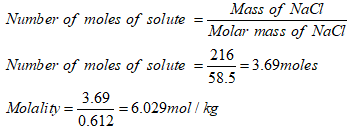Chemistry
10th Edition
ISBN:9781305957404
Author:Steven S. Zumdahl, Susan A. Zumdahl, Donald J. DeCoste
Publisher:Steven S. Zumdahl, Susan A. Zumdahl, Donald J. DeCoste
Chapter1: Chemical Foundations
Section: Chapter Questions
Problem 1RQ: Define and explain the differences between the following terms. a. law and theory b. theory and...
Related questions
Question
I have gotten this wrong repeatedly
![### Determining the Molality and Molarity of a Sodium Chloride Solution
In this educational exercise, you will determine the molality and molarity of a sodium chloride (NaCl) solution. The solution is prepared by adding 216.0 grams of solid NaCl to 612.0 grams of water. The density of the resultant saline solution is 1.1972 grams per milliliter (g/mL).
**Given Data:**
- Mass of NaCl = 216.0 g
- Mass of water = 612.0 g
- Density of saline solution = 1.1972 g/mL
**Formulas to Use:**
1. **Molality (m)**:
\[
\text{molality (m)} = \frac{\text{moles of solute}}{\text{mass of solvent (kg)}}
\]
2. **Molarity (M)**:
\[
\text{molarity (M)} = \frac{\text{moles of solute}}{\text{volume of solution (L)}}
\]
To find these quantities, follow these steps:
1. **Calculate the Moles of NaCl**:
- Molar mass of NaCl = 58.44 g/mol
- Moles of NaCl = \(\frac{216.0 \text{ g}}{58.44 \text{ g/mol}}\)
2. **Convert the Mass of Water to Kilograms**:
- Mass of water (kg) = \(\frac{612.0 \text{ g}}{1000}\)
3. **Determine the Volume of the Solution**:
- Total mass of solution = mass of NaCl + mass of water
- Volume of solution (mL) = \(\frac{\text{total mass}}{\text{density}}\)
- Convert volume from mL to L
4. **Calculate Molality**:
\[
\text{molality (m)} = \frac{\text{moles of NaCl}}{\text{mass of water (kg)}}
\]
5. **Calculate Molarity**:
\[
\text{molarity (M)} = \frac{\text{moles of NaCl}}{\text{volume of solution (L)}}
\]
**Input Fields:**
- **](/v2/_next/image?url=https%3A%2F%2Fcontent.bartleby.com%2Fqna-images%2Fquestion%2F7eaef044-20a7-420f-b57c-5d0c5f8d0743%2F5b6585ee-73db-4cff-99d4-25c4da29cd9d%2F4lms3k8_reoriented.jpeg&w=3840&q=75)
Transcribed Image Text:### Determining the Molality and Molarity of a Sodium Chloride Solution
In this educational exercise, you will determine the molality and molarity of a sodium chloride (NaCl) solution. The solution is prepared by adding 216.0 grams of solid NaCl to 612.0 grams of water. The density of the resultant saline solution is 1.1972 grams per milliliter (g/mL).
**Given Data:**
- Mass of NaCl = 216.0 g
- Mass of water = 612.0 g
- Density of saline solution = 1.1972 g/mL
**Formulas to Use:**
1. **Molality (m)**:
\[
\text{molality (m)} = \frac{\text{moles of solute}}{\text{mass of solvent (kg)}}
\]
2. **Molarity (M)**:
\[
\text{molarity (M)} = \frac{\text{moles of solute}}{\text{volume of solution (L)}}
\]
To find these quantities, follow these steps:
1. **Calculate the Moles of NaCl**:
- Molar mass of NaCl = 58.44 g/mol
- Moles of NaCl = \(\frac{216.0 \text{ g}}{58.44 \text{ g/mol}}\)
2. **Convert the Mass of Water to Kilograms**:
- Mass of water (kg) = \(\frac{612.0 \text{ g}}{1000}\)
3. **Determine the Volume of the Solution**:
- Total mass of solution = mass of NaCl + mass of water
- Volume of solution (mL) = \(\frac{\text{total mass}}{\text{density}}\)
- Convert volume from mL to L
4. **Calculate Molality**:
\[
\text{molality (m)} = \frac{\text{moles of NaCl}}{\text{mass of water (kg)}}
\]
5. **Calculate Molarity**:
\[
\text{molarity (M)} = \frac{\text{moles of NaCl}}{\text{volume of solution (L)}}
\]
**Input Fields:**
- **
Expert Solution
Step 1
Molality is equal to the number of moles of solute dissolved in per kg of solvent.
It is denoted by m.
Its SI unit is mol/kg.
Formula used:

Molarity is equal to the number of moles of solute dissolved in per litre of solution.
It is denoted by M.
Its SI unit is mol/L.
Formula used:

Step 2
To determine molaltiy of NaCl solution.
Mass of solvent = 612g =0.612kg.

Answer: Molality of the NaCl solution is 6.029mol/kg
Step by step
Solved in 3 steps with 9 images

Knowledge Booster
Learn more about
Need a deep-dive on the concept behind this application? Look no further. Learn more about this topic, chemistry and related others by exploring similar questions and additional content below.Recommended textbooks for you

Chemistry
Chemistry
ISBN:
9781305957404
Author:
Steven S. Zumdahl, Susan A. Zumdahl, Donald J. DeCoste
Publisher:
Cengage Learning

Chemistry
Chemistry
ISBN:
9781259911156
Author:
Raymond Chang Dr., Jason Overby Professor
Publisher:
McGraw-Hill Education

Principles of Instrumental Analysis
Chemistry
ISBN:
9781305577213
Author:
Douglas A. Skoog, F. James Holler, Stanley R. Crouch
Publisher:
Cengage Learning

Chemistry
Chemistry
ISBN:
9781305957404
Author:
Steven S. Zumdahl, Susan A. Zumdahl, Donald J. DeCoste
Publisher:
Cengage Learning

Chemistry
Chemistry
ISBN:
9781259911156
Author:
Raymond Chang Dr., Jason Overby Professor
Publisher:
McGraw-Hill Education

Principles of Instrumental Analysis
Chemistry
ISBN:
9781305577213
Author:
Douglas A. Skoog, F. James Holler, Stanley R. Crouch
Publisher:
Cengage Learning

Organic Chemistry
Chemistry
ISBN:
9780078021558
Author:
Janice Gorzynski Smith Dr.
Publisher:
McGraw-Hill Education

Chemistry: Principles and Reactions
Chemistry
ISBN:
9781305079373
Author:
William L. Masterton, Cecile N. Hurley
Publisher:
Cengage Learning

Elementary Principles of Chemical Processes, Bind…
Chemistry
ISBN:
9781118431221
Author:
Richard M. Felder, Ronald W. Rousseau, Lisa G. Bullard
Publisher:
WILEY